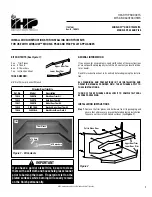
16
Pirani Vacuum Sensor System
Buffered Analog Output
The Series 917 Pirani Controller's analog output voltage is buffered. The
temperature compensated signal from the Pirani Sensor is buffered by a unity
gain amplifier, then connected to the
Accessory port. This signal has an
amplitude of approximately 0.03 V in vacuum to 3.25 V at atmosphere and
follows the voltage-versus-pressure curve shown on page 14. Since this
signal is not digitally processed, the Series 917 Pirani System is best suited
for applications in which measurement speed is important.
Use with Computers
The Series 917 Pirani System is designed to operate in highly automated
systems, especially those that are controlled by digital computers, as well as
in manual systems. It is compatible with a wide variety of computers,
interfaces, and software.
In order to take the fullest advantage of the System’s capabilities, an analog-
to-digital (A/D) converter should be used with an input voltage span of 0 to 5
V. The A/D conversion rate should be at least 6 Hz (150 msec conversion
time). A resolution of 12 bits is needed, corresponding to 1.22 mV per bit. The
A/D converter should have a differential input to ensure accurate
measurements.
Leak Detection
The Series 917 System’s Pirani Sensor’s inherent sensitivity to gas type
makes it useful for detecting leaks. It is a useful complement to a mass
spectrometer leak detector, which is most efficient in locating smaller leaks.
The Series 917 Pirani System quickly locates leaks in foreline and roughing
systems.
Since the pressure of a Pirani sensor is dependent upon the type of gas
measured, introducing a probe gas through the leak into a steady-state
system will change the measurement.
To use the Series 917 Pirani System as a leak detector, pump your vacuum
system to a base pressure and note the pressure reading while probing the
suspect components. The pressure will change, either to a higher or lower
indication, depending upon the thermal conductivity of the probe gas relative
to the system gas. The largest needle deflection indicates that the probe gas
is nearest the leak location. Repeat the test to confirm.
As with any leak testing, many factors can influence the sensitivity of the
test. These include 1) chamber volume, 2) system pressure, 3) probe gas, 4)
type of vacuum pump, 5) location of the Sensor or of the pump, and others
such as pumping speed, and size of tubing in the system.
1) Reducing the search area by minimizing the chamber volume will increase
the efficiency of the test.
2) Sensitivity to gas leaks is also pressure dependent due to the complex
nature of heat transfer at pressures above 10
-1
Torr and the presence of
significant radiation and end losses below 10
-3
Torr.
Содержание HPS 917
Страница 1: ...HPSTM Products Series 917 Pirani Vacuum Sensor System OPERATION AND MAINTENANCE MANUAL...
Страница 2: ......
Страница 6: ...Pirani Vacuum Sensor System...
Страница 29: ...23 Pirani Vacuum Sensor System Notes...
Страница 30: ...24 Pirani Vacuum Sensor System...
Страница 31: ......
Страница 32: ......











































